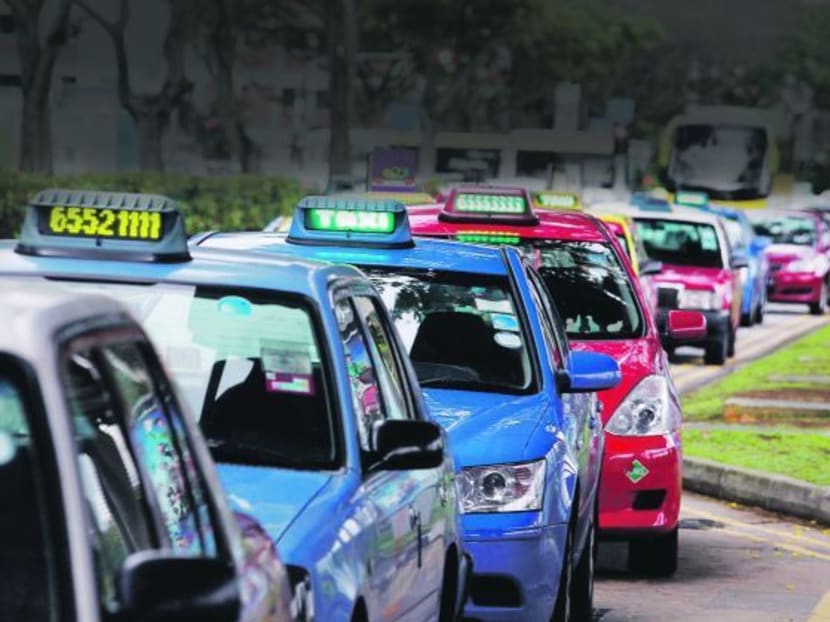Authorities introduce parameters for taxi fares
SINGAPORE — After more than a year spent looking for ways to make it simpler for commuters to compare prices across cab companies, the authorities have decided to standardise how charges are levied, but continue letting operators decide what they want to charge. In other words, companies will have to adhere to a uniform standard for when meters jump, when surcharges are imposed and when the different booking fees kick in.
SINGAPORE — After more than a year spent looking for ways to make it simpler for commuters to compare prices across cab companies, the authorities have decided to standardise how charges are levied, but continue letting operators decide what they want to charge. In other words, companies will have to adhere to a uniform standard for when meters jump, when surcharges are imposed and when the different booking fees kick in.
How much they choose to charge for each of these components, however, will remain their call, as long as it applies company-wide. Fare structures are currently largely similar across all six taxi companies, except when it comes to flag-down fares — the difference spans 70 cents for normal taxis and S$1.50 for premium models.
Despite persistent grouses from commuters about this, the Land Transport Authority (LTA) and Public Transport Council (PTC) said it chose to leave pricing in the hands of operators to balance the conflicting interests of cab companies and commuters.
During consultations with nearly 100 representative from the industry and regular commuters, “taxi companies indicated that if they were required to harmonise flag-down fares, they would likely do so by levelling them upwards, in part to be fair to taxi drivers who currently charge higher flag-down fares”, they said. Commuters, on the other hand, were against a single rate being averaged upwards.
“It will not be possible to fully satisfy these conflicting interests,” said the LTA and the PTC in a joint statement.
“As mandating the harmonisation of flag-down fares may lead to higher flag-down fares for commuters, we will leave them as they are for now. Over time, taxi companies may, on their own accord, adjust and harmonise flag-down fares within their own fleets in response to market conditions.”
The new requirements, which will kick in in the second half of this year, are to “prevent taxi fares from becoming even more complex for commuters in the future”, added the LTA and PTC.
Taxi fares have been deregulated since September 1998. Cab companies are allowed to set their own fares to respond to market conditions and impose surcharges to incentivise taxi drivers to serve locations and time periods where demand is high.
It has led to a situation where there are different fare structures within an individual operator — depending on the car model — and more than 10 different types of surcharges. Collectively, the six companies have more than 28,500 cabs on the roads.
Under the new rules, individual taxi companies can only have one set of unit fares (the fare jump after a set distance or waiting time) each, for their normal and premium taxi fleets. Unit fares will also be based on a uniform parameter across the industry — every 400m from the second to tenth kilometre, and every 350m after the 10thkm, or for every 45 seconds of waiting.
Fees for peak, off-peak and advance bookings must also be kept to one set within each operator. For example, Prime currently charges three fees — S$3.50, S$5 and S$6 — for peak-hour booking from 6am to 9.30am from Monday to Friday. This will be reduced to just one fee. The other standardisations required, such as location- and time-based surcharges, are already largely in place. For instance, all companies must use the same timings for peak period surcharges and charge a uniform percentage of metered fare.
Asked why the large number of surcharges is not reduced, the LTA and PTC said it could lead to longer waiting times during certain timings and at certain locations, and also affect the income of taxi drivers.
The six taxi companies will agree on the parameters for the various fare components on their own, with no approval from the authorities needed. Only if the companies fail to settle on a common standard will the PTC step in to arbitrate.
Commenting on the new rules, the National Taxi Association said while they will prevent taxi fares from becoming more complex in future, they fall short in terms of meeting commuters’ expectations. “People will still be asking how come it’s not further simplified,” said the association’s executive adviser Ang Hin Kee.
Agreeing, student Kane Raymond, 21, said: “The problem is that prices (across companies) are different and sometimes we’re afraid to take a certain company’s cabs because they’re more expensive. By standardising the prices, commuters would have more choices.” ADDITIONAL REPORTING BY VALERIE KOH








